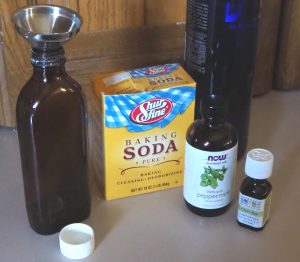Here in the Treehouse, we have to get by on what’s at hand. This series explores simple, nature-friendly alternatives to conventional products and practices.
Plastic bottles are amazing. They can hold all different kinds of things, mostly liquids. They’re highly squishable, usually (depends on the plastic).
And they will last for millions of years.
Long after I’m dead, that plastic water bottle will be kicking around somewhere, causing trouble. I’m on a campaign to eliminate plastic from my life as much as possible. Especially single-use plastic. And hey, when you live in a treehouse, and going to the store is a big deal, you tend to find alternatives.
I use mouthwash to brush my teeth (on the advice of my dental hygienist, years ago), which has the advantage of also eliminating toothpaste tubes. When I came to the treehouse, I decided to stop buying commercial mouthwash, and researched a bunch of recipes. This one is tweaked for my preferences. I usually make a large batch of mouthwash and store it, refilling this glass bottle which I keep on my sink.
Here’s my alternative to mouthwash that comes in a single-use plastic bottle.

Ingredients:
-
- 1 1/4 cup water (distilled or boiled and cooled)
- 3/4 teaspoon sea salt
- 3/4 teaspoon baking soda
- 6-8 drops peppermint oil
- 2 drops clove oil
- 1/4 cup vodka (optional)
Mix all ingredients in a bottle, preferably glass. You can add more water if you prefer. Cap and store.
The vodka isn’t essential, but after years of brushing with alcohol-based mouthwash, I find I prefer it. Makes my mouth feel fresher. This could be a result of conditioning, but what the heck.
You can vary the essential oils. Maybe you prefer cinnamon and vanilla. Some people like tea tree oil (I tried it – no thanks). Just make sure to use food-safe oils. And watch it on the clove oil – that stuff is powerful!

I think I’m going to try this once my current supply runs out (which gives me time to get some essential oils and vodka).
Have fun! Play around with the flavors, and let me know what you decide on!
Tea tree oil doesn’t taste nice. It is, however, very helpful in minimising some mouth problems.
The early settlers in Australia, who named the plant because it was their tea substitute, could probably attest to this.
Thanks, Gillian – I didn’t know the origin of the name “tea tree.” I kept confusing it with the Hawaiian “ti plant” which is different (though also very aromatic).